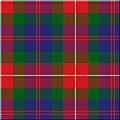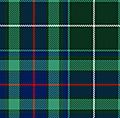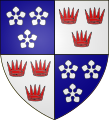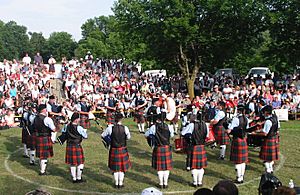Clan Fraser of Lovat facts for kids
Quick facts for kids Clan Fraser of Lovat |
|||
|---|---|---|---|
| Clann Friseal | |||
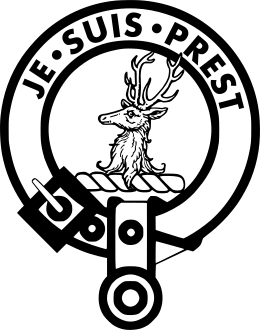
Crest: A buck's head, erased, Or, armed, Argent
|
|||
| Motto | Je suis prest (I am ready) | ||
| War cry | "A Mhor-fhaiche" or "Caisteal Dhuni" |
||
| Profile | |||
| Region | Highland | ||
| District | Inverness-shire | ||
| Plant badge | French fraise (Strawberry) | ||
| Animal | Stag | ||
| Pipe music | Lovat's March | ||
| Chief | |||
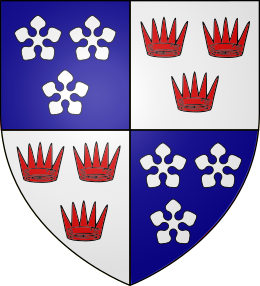 |
|||
| The Rt Hon. Simon Fraser | |||
| The 16th Lord Lovat (Mac Shimidh Mòr) | |||
| Historic seat | Beaufort Castle | ||
|
|||
|
|||
|
|||
|
|||
|
|||
Clan Fraser of Lovat (Scottish Gaelic: Friseal [ˈkʰl̪ˠãũn̪ˠ ˈfɾʲiʃəl̪ˠ]) is a famous Highland Scottish clan. It is the main part of the larger Clan Fraser. The Frasers of Lovat have lived near Inverness since the 1200s. This is when the clan's first leader got land there.
The Clan Fraser of Lovat has always been important in the Inverness-shire area. They have been involved in many big wars and political events in Scotland. Even today, "Fraser" is a very common family name around Inverness. The clan's current leader is Simon Fraser. He is the 16th Lord Lovat and the 25th Chief of Clan Fraser.
Contents
Clan Fraser: A Look at Their History
Where Did the Name "Fraser" Come From?
The exact start of the name "Fraser" is not fully known. Many people believe it came from France. Some early spellings of the name were "de Fresel" or "de Friselle." These names might have come from the Anjou area of France.
One old story says the name comes from the French word fraise, which means strawberry. It is said that a French nobleman named Julius de Berry served King Charles the Simple a dish of strawberries. The King was so pleased that he knighted de Berry. The new knight then took strawberry flowers as his family symbol. He also changed his name to "Fraiseux" or "Frezeliere." This story might be a fun legend. It could be that the strawberry symbol was chosen because it sounded like the name "Fraser."
The first time the name "Fraser" appeared in Scotland was in 1160. A man named Simon Fraser owned land in East Lothian. He gave a church to monks at Kelso Abbey. Over time, Frasers moved to other parts of Scotland. These included Stirling, Angus, Inverness, and Aberdeen.
Brave Frasers in Scottish Wars
During the Wars of Scottish Independence, a hero named Sir Simon Fraser fought for Scotland's freedom. He fought alongside famous leaders like William Wallace and Robert the Bruce. Sir Simon is known for winning the Battle of Roslin in 1303. He led only 8,000 men against a larger English army. At the Battle of Methven in 1306, Sir Simon saved King Robert the Bruce's life three times! For his bravery, he was supposedly given three crowns to add to the Lovat family symbol. Sadly, he was captured by the English and executed in 1306.
Sir Simon's cousin, Sir Alexander Fraser of Touchfraser and Cowie, was luckier. He fought at the Battle of Bannockburn in 1314. After the battle, he married Robert the Bruce's sister and became the King's Chamberlain. The Frasers of Philorth clan leaders come from this Alexander. The Frasers of Lovat clan leaders come from Alexander's younger brother, another Sir Simon Fraser. This Sir Simon died fighting at the Battle of Halidon Hill in 1333.
Clan Battles in the 1400s and 1500s
Like most Highland clans, the Frasers often fought against other clans. They had two main war cries. One was "Caisteal Dhuni" (Castle Dounie/Downie). This referred to their old castle and clan home. The other was "A Mhòr-fhaiche" (The Great Field).
In 1429, the Clan Fraser of Lovat beat the Clan Donald at the Battle of Mamsha. The Frasers also helped the Clan Munro in battles against the Clan Mackenzie in 1452 and 1454.
A very famous battle was the Battle of the Shirts in 1544. The Frasers fought against the Clan Macdonald of Clanranald. This was over who should be the chief of Clan Ranald. About 300 Frasers were ambushed by 500 MacDonalds. Only five Frasers and eight MacDonalds survived. Both the Fraser chief, Hugh Fraser, 3rd Lord Lovat, and his son died in this battle.
In 1562, the Clan Fraser of Lovat helped Mary, Queen of Scots, at the Siege of Inverness. When the Queen was in danger, many brave Scots came to help her. The Frasers and Munros were known as the bravest clans in the north. They captured Inverness Castle for the Queen.
The Frasers in the 1600s Civil War
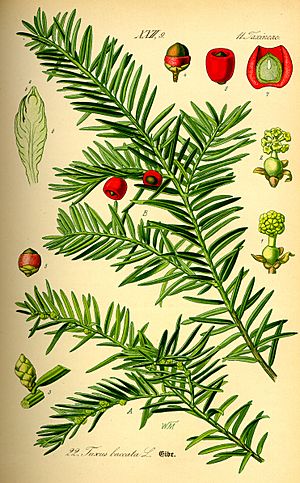
In 1645, the Frasers fought against the Royalist leader James Graham, 1st Marquess of Montrose, at the Battle of Auldearn. Many Frasers died in this battle.
In 1649, the Clan Fraser of Lovat attacked Inverness Castle again. This time, they were part of a Royalist uprising. They took the castle and strengthened its defenses. But when a large army came, the clans retreated. The next year, in 1650, the Frasers of Lovat defended Inverness Castle against Royalists.
The Frasers also fought against Oliver Cromwell's forces at the Battle of Dunbar in 1650. They joined King Charles II's army in 1651. They fought at the Battle of Worcester, where the King's army was defeated.
In 1689, King James VII was removed from the throne. Many Highland clans, including some Frasers, supported him. The chief of Clan Fraser, Hugh Fraser, tried to stop his clan from joining the uprising. But they marched without him and fought at the Battle of Killiecrankie.
The 1700s and Jacobite Risings
The Jacobite Rising of 1715
During the Jacobite rising of 1715, Simon Fraser, 11th Lord Lovat, known as "the Fox," supported the British Government. He surrounded the Jacobite forces in Inverness. The Inverness forces gave up to Fraser on the same day as the Battle of Sheriffmuir.
The Jacobite Rising of 1745
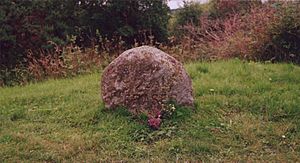
In 1725, the British government asked Lord Lovat to lead a company of Highland soldiers. But later, he lost this command. Because of this, Simon Fraser, 11th Lord Lovat, decided to support Charles Edward Stuart (Bonnie Prince Charlie) in the Jacobite rising of 1745. He said he did it out of anger for losing his company.
Frasers were on the front lines of the Jacobite army at the Battle of Falkirk and the famous Battle of Culloden in 1746. At Culloden, Charles Fraser of Inverallochy, who led the clan, was badly hurt. Many Frasers fought bravely.
After the battle, Castle Dounie, the Fraser clan's home, was burned down. Simon Fraser, 11th Lord Lovat, was captured. He was put on trial and executed in London in 1747. His lands and titles were taken by the Crown.
After Culloden: A New Start
Castle Dounie was replaced by a smaller building. In 1774, some of the Lovat lands were given back to Lord Lovat's son, Simon Fraser. He had become a major general in the British Army. He had to pay a large sum of money to get the lands back. Later, he raised a Fraser regiment for the British Army. This regiment fought in Canada in the 1750s, including at Quebec.
Frasers Around the World
Fighting in the New World
The Seven Years' War
Under Simon Fraser, a regiment of Frasers called the 78th Fraser Highlanders was formed. About 1,400 men fought against the French and Native Americans in the colonies and Canada from 1757 to 1759. They fought under General Wolfe. It is said that a Fraser's knowledge of French helped the British troops at the Battle of the Plains of Abraham. This battle led to the capture of Quebec.
The American Revolution
During the American Revolutionary War, Simon Fraser, now a General, raised another 2,300 men. This was the 71st Fraser Highlanders. Many of these men were not Frasers, as the number of Frasers had gone down after Culloden.
Frasers Across the Globe
After the war against the French in Quebec, many Frasers settled in Canada and the United States. Later, many more moved to these countries, and to Australia and New Zealand. Both Australia and New Zealand have even had a Fraser as prime minister! Frasers in the US continued their military tradition, fighting in the American Civil War. Frasers from all over the world also fought in the First World War and the Second World War.
Fraser Tartans
Who is the Clan Chief?
In 1984, the Court of the Lord Lyon made Lady Saltoun the "Chief of the name and arms of the whole Clan Fraser." This caused some confusion. Many people thought this meant she was the chief of the entire Clan Fraser. However, the Lord Lyon only recognized her as the head of the older branch of the wider Fraser family. She was allowed to use the basic Fraser family symbol.
The official symbol of Clan Fraser of Lovat is special. It shows three strawberry flowers in the first and fourth sections. It also shows three old crowns in the second and third sections. Only the Lord Lovat is allowed to use this symbol without any changes.
Fraser Castles
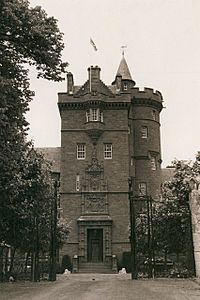
The Clan Fraser of Lovat has owned several castles over time:
- Lovat Castle: This was the first home of the Fraser of Lovat chiefs.
- Castle Dounie: This was the main home of the Fraser of Lovat chiefs. It was near Beauly, Inverness-shire. The English attacked it in 1303. In 1650, Oliver Cromwell's forces captured and damaged it. After the 1745 uprising, the castle was destroyed. However, the chief's son, Simon, got the land back in 1771. The castle was rebuilt as Beaufort Castle in 1882. The family had to sell it in the 1990s, but they still live near Beauly.
- Dalcross Castle: The Frasers of Lovat built this castle in 1620.
- Moniack Castle: This castle near Beauly was also owned by the Frasers of Lovat.
- Reelig House: The Frasers have owned this house near Beauly since the 1600s. The Frasers of Reelig still live there today.
Fraser Military Regiments
Frasers are known for their fighting spirit. They have served in many wars. These include defending Scotland, fighting in the Scottish Wars of Independence, and the Jacobite risings. They also fought in both World Wars and continue to serve today. Some famous Fraser regiments include:
- The 78th Fraser Highlanders: Formed in 1758, they fought in North America.
- The 71st Fraser Highlanders: Formed in 1775 for service in North America.
- The Fraser Fencibles Regiment: Raised to protect Scotland from Napoleon Bonaparte. They also served in the Irish Rebellion of 1798.
- The Lovat Scouts: Formed in 1900 for the Second Boer War. They also fought in the First and Second World Wars. Today, they are part of the 51st Highland Volunteers.
The Clan Today
Today, the Clan Fraser has thousands of members all over the world. Many Frasers live in Canada and the United States. Smaller groups are in Australia, New Zealand, and other countries. Of course, many still live in Scotland. In 1951, Lord Lovat gathered about 7,000 Frasers at Beaufort Castle. In 1997, about 30,000 to 40,000 Frasers from 21 countries came together for a worldwide clan gathering at Castle Fraser.
Clan Fraser in Popular Stories
- The book Outlander by Diana Gabaldon features a fictional character named Jamie Fraser from Clan Fraser of Lovat.
- The fantasy series "The Adept" by Katherine Kurtz and Deborah Turner Harris includes characters from Clan Fraser, like Peregrine Lovat.
See also
- Lord Lovat
- Lord Fraser
- Lord Saltoun
- List of BR 'Clan' Class locomotives


